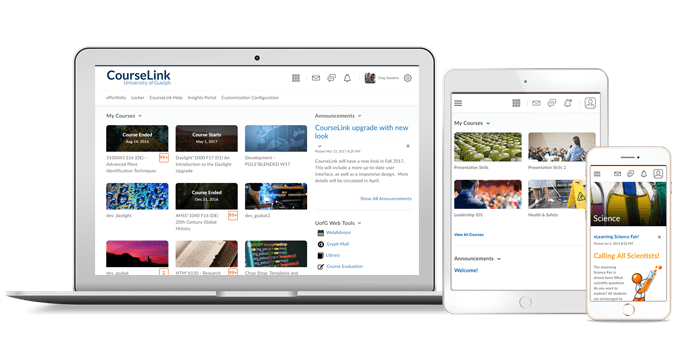
Students and Instructors
Brightspace Pulse – OAuth2-compliance added for user login
The update to OAuth2 switches users over from the existing API authentication workflow. Improvements to Pulse authentication will require all Pulse users to re-login to CourseLink after they update the Pulse app. This is to facilitate Pulse and CourseLink authentication consistency and is a one-time requirement. The change will occur in two parts:
- Updating the Pulse app.
- Opening an external browser to handle authentication.
To sign into Pulse with OAuth2:
- From your device, tap the Brightspace Pulse icon.
- Learn more about Brightspace Pulse by swiping left/right or proceed to the next step by tapping Next.
- Tap Pick Your School.
- Search for Guelph.
- Tap on CourseLink.
- Sign into CourseLink.
Instructors Only
Dropbox – Access new shortcuts to undo and redo PDF annotations on evaluations
Previously, the only way to remove PDF annotations in Dropbox was to use the eraser tool or delete the selection. Now, an undo/redo button is added for PDF annotations when evaluating in Dropbox. Alternatively, standard keyboard shortcuts are now also supported for undoing and redoing annotations:
- Ctrl-z | Command-z (Apple) – Undo
- Ctrl-Shift-z | Command-Shift-z (Apple) – Redo

Dropbox – Apply the filters “Show everyone” and “Show all groups” for individual and group assignments
Previously, in Dropbox, the search filter defaulted to Users with submissions for individual assignments and Submitted groups for group assignments. Now, instructors will instead default to Show everyone for individual assignments and Show all groups for group assignments. These modified filters are the new default search option. After applying one of these default filters, instructors can apply additional filters to improve search optimization.
Data also shows that instructors prefer to display all users before applying additional filters.
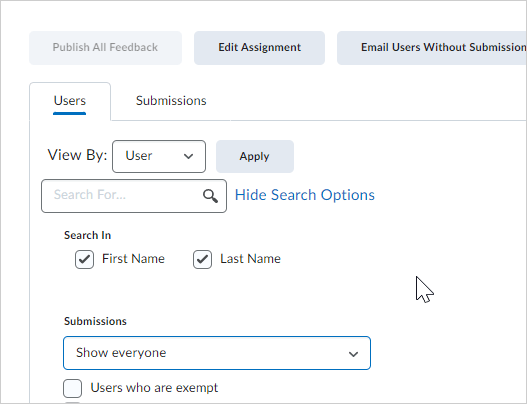
HTML Editor – Easily insert code snippets with the Insert Code option
There is a new option in the HTML Editor that allows instructors to directly insert a code snippet into their content. This is done by selecting the Other Insert Options menu from the Editor toolbar, and then selecting the new Insert Code option. From there, instructors select their programming language from a list of available choices and add their code into the interface to format before inserting it into the Editor.
Previously, instructors had to use the <code> tag and build out their own code to add a code snippet in the editor.
Note: The Insert Code option is not available in the Quizzes tool.
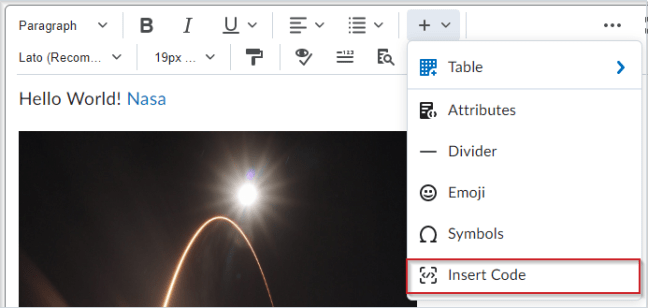

HTML Editor – Insert Stuff now includes Media Library
Media Library is now available as an option within Insert Stuff. This allows users to embed any audio or video files added via Content since January 2022 and any existing Audio Notes and Video Notes into any supported HTML Editor field.
Previously, Media Library was not accessible from Insert Stuff and it was only possible to insert Video notes via Search for Video or Insert Video Note.
This release also allows instructors to embed a new inline Audio Player using Insert Stuff.
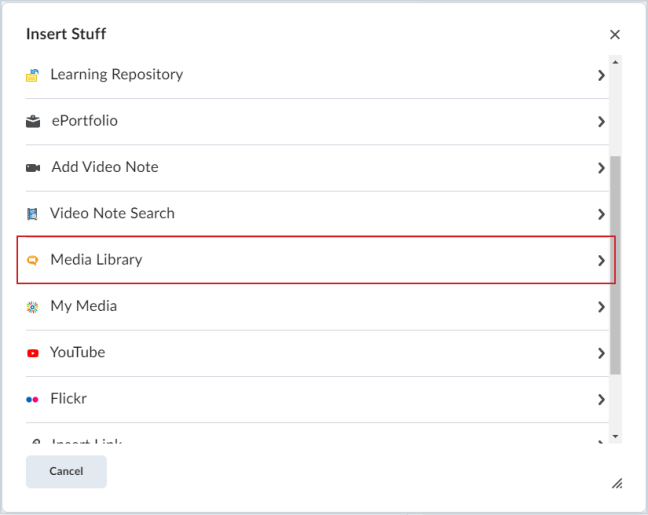
HTML Editor – Quickly access and manage the files you uploaded using Insert Stuff
This feature releases an improvement to the HTML Editor > Insert Stuff dialog.
Now, when you are in the HTML Editor and you upload a file using Insert Stuff, a message appears indicating that the files uploaded using Insert Stuff are saved in the Manage Files area. The message also indicates that files in the Manage Files area are potentially accessible to all users enrolled in the course or to anyone who has access to the course.
As best practice, do not include individual learner feedback in the files you are uploading using Insert Stuff.
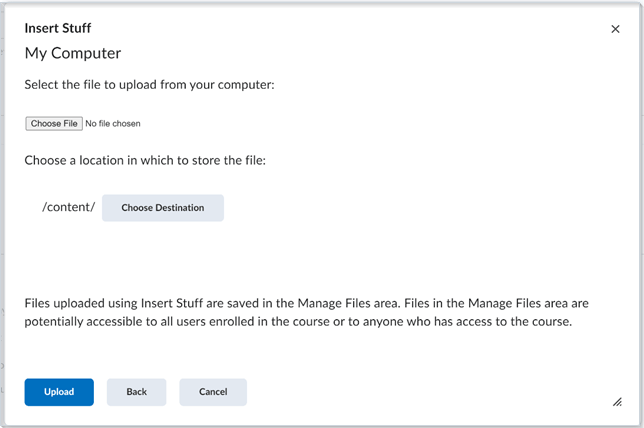
Intelligent Agents – Create more flexible agents with fewer criteria
On the New Agent page, in the Criteria section, all selections under Take Action on Activity are now optional. This means users can now create a new Intelligent Agent that applies to certain roles and doesn’t require any other criteria. Users are still required to select one of the options under Role in Classlist.
Previously, to create an Intelligent Agent, users had to select the roles the agent applies to, and one or more conditions the agent must check against: login activity, course activity, or release conditions. If a user attempted to save the agent without selecting a condition to check against, they received an error saying No Agent Criteria Defined.
Also in this update, on the New Agent page, in the Criteria section, under Role in Classlist, the option All users visible in the Classlist is no longer selected by default. This is a precaution to prevent users from accidentally creating an agent that runs against everyone.

Quizzes – End of Life for Disable Right Click option
As of this release, the Disable Right Click option in quizzes is removed from Quizzes in CourseLink. The option is no longer available in Quiz Setup, and existing quizzes with the setting will no longer enforce the limitation on learners.
This option was previously intended to allow Instructors to disable right-clicking during the time a learner was taking quiz, thus making it more difficult for learners ability to copy or print the quiz and share it with others. However, as browsers have reduced the ability for web sites to control end-user behavior, the Disable Right Click setting could not necessarily be applied to all students, and it provided a false sense of security around quiz content.
For more information concerning this change, refer to Advanced Notice: Retirement of Quizzes “Disable Right Click” Setting in Brightspace Community.
Quizzes – Save time and prevent data loss with the Restore Deleted Quizzes functionality
This feature adds a new option in quizzes that allows instructors to restore deleted quizzes. This option appears in the More Actions menu in the Quizzes tool. Instructors using this option are provided with a list of deleted quizzes that indicates when they were deleted and by whom, along with a button to restore a selected quiz.
Restored quizzes automatically have any associated quiz attempts that were already taken, statistics, and scores for those quiz attempts restored as well. Learning Outcomes associated to quiz questions are unaffected, and re-appear with the questions when the quiz is restored. Links to a grade item are not restored.
The Delete Quizzes permission has been renamed to Delete and Restore Quizzes.
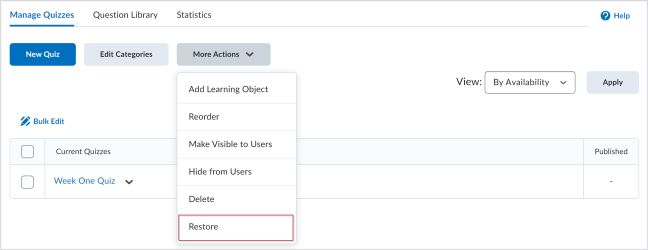
Zoom Cloud Retention – Some older recordings to be deleted on September 1, 2022
In accordance with communication sent out earlier this year, Zoom Cloud is intended for temporary, non-archival storage, and recordings will be deleted based on the following schedule:
| Deletion Date | Delete up to: | Semesters Retained |
| September 1, 2022 | August 31, 2021 | F21, W22, S22 |
| January 3, 2023 | December 31, 2021 | W22, S22, F22 |
| May 1, 2023 | April 30, 2022 | S22, F22, W23 |
As of September 1, 2022, any Zoom meeting cloud recordings created up to and including August 31, 2021 will be deleted.
After deletion, all deleted files will be stored in the associated Zoom account’s Trash for an additional 30 days and may be recovered by following the steps outlined on Zoom’s Recover a deleted cloud recording page. After the 30-day Trash timer expires, the recordings will be permanently deleted.
If you have multiple UofG Zoom Pro accounts, such as a personal account (jdoe@uoguelph.ca) and an organizational account (code1000@uoguelph.ca), please be certain to check all impacted accounts to avoid losing any required recordings.
How to Retain Recordings (if required)
If there is a need to retain recordings stored on the Zoom cloud long term, it is recommended they be transferred to a University-approved storage solution, like OneDrive.
To help facilitate the process of copying Zoom cloud recordings to OneDrive, OpenEd developed the Zoom Transfer Tool, which allows staff and faculty with UofG Zoom Pro accounts to simply select Zoom cloud recordings from their account to copy to the associated UofG OneDrive account. The Zoom Transfer Tool can also be set to automatically copy all Zoom cloud recordings to OneDrive by enabling the Automate Transfers option.
Questions or Concerns
If you have questions, concerns, or require assistance using the Zoom Transfer Tool, please contact CourseLink Support.
Contact
If you have any questions about the updates, please contact CourseLink Support at:
courselink@uoguelph.ca
519-824-4120 ext. 56939